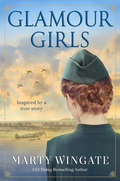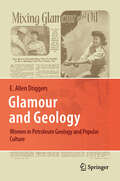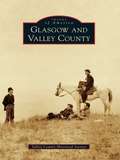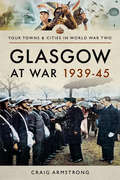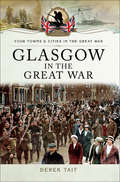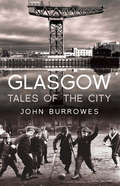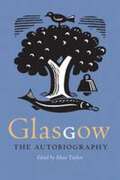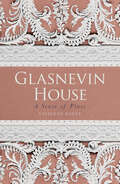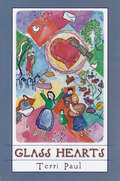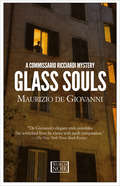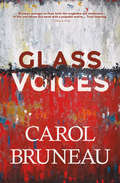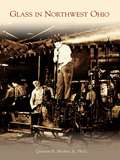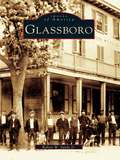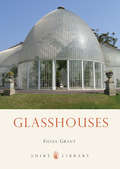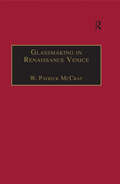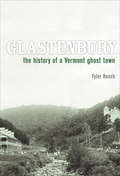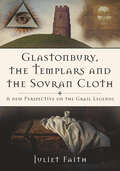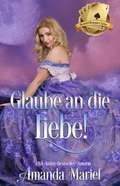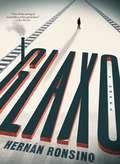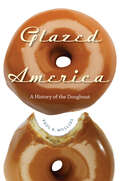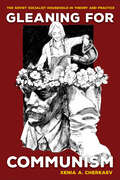- Table View
- List View
Glamour Girls: A Novel
by Marty WingateUSA Today bestselling author Marty Wingate's historical debut is "like reading a personal diary of the brave women who were unsung heroes of WWII," (Rhys Bowen, Royal Spyness mysteries) and will delight readers of Kelly Rimmer's The Things We Cannot Say and Noelle Salazar's The Flight Girls.During World War II, farmer's daughter Rosalie Wright becomes a pilot assisting the RAF. But will a romantic rivalry send her aerial dreams plummeting to earth?Ever since she was 10 years old, Rosalie Wright's eyes have been on the skies. But at the age of 18, on the verge of earning her pilot's license, the English farmer's daughter watches her dreams of becoming an aviatrix fly away without her. Britain's entry into World War II brings civilian aviation to a standstill. Then, Rosalie's father dies, leaving her, her mother, and her brothers to run the farm.Everything changes when she learns that the Air Transport Authority is recruiting women pilots to ferry warplanes across Britain to RAF bases. Despite her mother's objections, Rosalie cannot resist the call of her country--and the lure of the skies. During her training on Gipsy Moth aircraft, Rosalie forms a fast friendship with fellow flyer Caroline Andrews. Her trusty Ferry Pilots Notebook by her side, Rosalie delivers to five airfields in a day--while fighting an endless battle against skeptical male pilots and ground crews.She would much rather spend her time on the wing than on the arm of any man...until she meets gruff pilot Snug Durrant and RAF squadron leader Alan Chersey. Snug is a cynical, wisecracking playboy, and Alan is every WAAF's heartthrob...and Rosalie catches both their eyes. As the war drags on, and casualties mount, will love and tragedy send Rosalie's exhilarating airborne life crashing to the ground?
Glamour and Geology: Women in Petroleum Geology and Popular Culture
by E. Allen DriggersDuring the twentieth century, especially during World War II, female geologists were potrayed as having a glamourous and unique job. Newspapers, the oil industry, and other publications published stories about the glamorous working geologist, comparing them to movie stars and scientists working on the important production of oil. This book explores the image of the female geologist as it changed from the “accomplished” woman of the Victorian era to the professional, and glamourous geologists of World War II and beyond. Women working in geology, especially petroleum geology, embraced the image and some participated in its promotion. In those same newspaper articles, some geologists began to speak out and ultimately discuss some of the problems they experienced while working in the field and in industry. This book discusses the role of working women geologists not only in the profession, but as a part of popular culture in the twentieth century.
Glasgow and Valley County
by Valley County Historical SocietyOnce known only as "Siding 45," Glasgow, Montana, was named by a railroad clerk's random finger poke on a spinning globe in 1887. Resourceful land speculators lured its first homesteaders with the promise, "Pin your faith in Glasgow and you shall wear diamonds." Successful farmers and cowboys initially made the community an agricultural center and the seat of Valley County. The 1930s drought and depression eras brought hard times, however, before the construction of the New Deal Fort Peck Dam helped reinvigorate Valley County communities. Faithful to their pioneer legacy, the people of the "Hi-Line" have more recently successfully refocused on long-established agriculture and developing tourism to continue the historic saga of northeast Montana.
Glasgow at War, 1939–45 (Your Towns & Cities in World War Two)
by Craig ArmstrongAn in-depth look at how Scotland&’s largest city and its residents were affected by the Second World War, with photos included. Scotland was of grave strategic importance during World War II because of its geographical position, and Glasgow was the location of a significant number of important military and civil organizations as well as housing industry vital to the national war effort. As a result, Glasgow attracted enemy attention on many occasions—with the city and its hinterland being heavily raided by the Luftwaffe. These included the infamous raid on Clydebank in March 1941, which killed over five hundred civilians and left only seven houses undamaged in the town. Although Glasgow&’s shipyards, munitions factories, and other industries were all vital, so too was the location of the city itself. The River Clyde was the end point for many Atlantic convoys bringing precious food, material, and men to the war-struck British Isles, and the city was thus a vital link in the nation&’s war effort. No member of the population of Glasgow escaped the war. Huge numbers of men and women from the area came forward for service in the military or in roles involving the Home Guard, ARP services, nursing, and vital war industries. Residents struggled to maintain a household under strict rationing and the stresses of wartime life, and children were evacuated from the city to rural areas to escape the bombing campaigns. Glasgow was also home to a sizable Italian community, which was badly affected by internment and tight restrictions on movement and civil rights. The Italian community was also subjected to violent attacks when rioting mobs attacked Italian-owned business throughout the city. Glasgow at War 1939-1945 paints a portrait of a city fighting to survive, and poignantly commemorates the efforts and achievements of workers, fighters, and families divided.
Glasgow in the Great War
by Derek TaitWhen news of the war broke out in 1914, nothing could prepare the citizens of Glasgow for the changes that would envelop their city over the next four years. The story of Glasgow in the Great War is both an interesting and intriguing one. This book covers this historic citys involvement from the commencement of the Great War in July 1914, to the Armistice in November 1918, describing in great detail what happened to the city and its people, including their everyday lives, entertainment, spies and the internment of aliens living within the city.Glasgow played a key role in the deployment of troops to Northern Europe as well as supplying vital munitions. Local men responded keenly to recruitment drives and thousands of soldiers were billeted in the city before being sent off to fight the enemy overseas. The city also played a vital role in caring for the many wounded soldiers who returned home from the Front.The effect of the war on Glasgow was great. By the end of the conflict, there wasn't a family in Glasgow who hadn't lost a son, father, nephew, uncle or brother. There were tremendous celebrations in the streets as the end of the war was announced but the effects of the war lasted for years to come.Glasgow in the Great War features many forgotten news stories of the day and includes a considerable collection of rare photographs last seen in newspapers nearly 100 years ago.
Glasgow: Tales of the City
by John BurrowesNot only has Glasgow produced some incredible personalities, it has also been witness to some of the greatest happenings of our times. These outstanding people and epoch-making events are featured in Glasgow: Tales of the City. As a result of painstaking research, some startling new facts have emerged about the life and times of some of the city's most interesting characters. The many individuals documented in this book include the world's greatest pilot, whose many flying feats are still held in great awe today and unlikely ever to be repeated. He was hailed as a hero in America, they gave a him a ticker-tape reception in New York and Hollywood begged him to be a star. More recently, Glasgow was popularised by a TV programme about the city's tough police officer Taggart. The role of the Glasgow detective made Mark McManus one of Scotland's first international TV stars, and Mark's own life story makes equally compelling reading.Before Billy Connolly, Glasgow's greatest-ever comedian was Lex McLean. He smashed all the box-office records in a Glasgow theatre and became a legend in his own lifetime. His story has never before been told in such detail. This is undoubtedly one of the most fascinating studies of Scotland's largest city ever published.
Glasgow: The Autobiography
by Alan TaylorThe story of a Scottish city as seen by its residents and visitors: &“It&’s a fine treasure-house—and even Glaswegians may learn something new from it.&” —Scotsman This is the story of the fabled former Second City of the British Empire, from its origins as a bucolic village on the rivers Kelvin and Clyde, through the Industrial Revolution to the dawning of the second millennium. Arranged chronologically and introduced by journalist and Glasgowphile Alan Taylor, the book includes extracts from an astonishing array of writers. Some, such as William and Dorothy Wordsworth, Dirk Bogarde, and Evelyn Waugh, were visitors and left their vivid impressions as they passed through. Many others were born and bred Glaswegians who knew the city and its inhabitants—and its secrets—intimately. They come from every walk of life and, in addition to professional writers, include anthropologists and scientists, artists and murderers, housewives and hacks, footballers and comedians, politicians and entrepreneurs, immigrants and locals. Together they present a varied and vivid portrait of one of the world&’s great cities in all its grime and glory—a place at once infuriating, frustrating, inspiring, beguiling, sensational, and never, ever dull.
Glasnevin House: A Sense of Place
by Vivienne KeelyThe story of Glasnevin House and Demesne, now Holy Faith Convent, is intertwined with the development of the area from the time of the early monks, through the medieval period when it was a farm of Christ Church, to the Georgian building of Mitchell and its nineteenth-century occupancy by the Lindsay family and the Sacred Heart sisters. The story continues with the arrival of the Holy Faith sisters in 1865 and their ongoing stewardship and development of the land. As this book opens with the contemplation of its surroundings, so it closes with the description of the new centre, which draws on natural beauty and the traditional spiritual influences that help us better engage with the modern world.
Glass Hearts
by Terri PaulA remarkable first novel that centers around Serene, a young girl whose father has vanished from their small Hungarian village just before World War I, leaving his beleaguered Jewish family to fend for themselves. Serene is 5 1/2 years old when we meet her in 1913. For the next six years, she seeks through dreams and visions to recover her father and to deal with the conflicting values and beliefs of her tightly knit family and the society which is unraveling around her.
Glass Souls: A Commissario Ricciardi Mystery (The Commissario Ricciardi Mysteries #8)
by Maurizio de GiovanniThe eighth Commissario Ricciardi historical mystery from the author of The Bottom of Your Heart &“will surprise readers at every turn&” (La Reppublica). In the abyss of a profound personal crisis, Commissario Ricciardi feels unable to open himself up to life. He has refused the love of both Enrica and Livia and the friendship of his partner, Maione. Contentment for Ricciardi proves as elusive as clues to the latest crime he has been asked to investigate. The beautiful, haughty Bianca, countess of Roccaspina, pleads with Ricciardi to investigate a homicide that was officially closed months ago. In the tense, charged atmosphere of 1930s Italy, where Benito Mussolini and his fascist thugs monitor the police closely, an unauthorized investigation is grounds for immediate dismissal and possible criminal charges. But Ricciardi&’s thirst for justice cannot be sated. A tightly plotted historical noir novel, this eighth installment in the Commissario Ricciardi series is a gripping meditation on revenge and justice in which each character&’s soul reveals itself to be made of glass. &“The construction of Glass Souls is remarkable. It&’s like a very sophisticated mosaic in which each protagonist occupies precisely the right amount of space.&” —La Reppublica &“Love, longing, and loss suffuse de Giovanni&’s elegiac, autumnal eighth Commissario Ricciardi mystery set in 1930s Naples . . . Though Ricciardi risks infuriating his bosses—and unknowingly even greater danger from the Fascist forces who have him under surveillance—he can&’t resist the conundrum. Nor in all likelihood will readers.&” —Publishers Weekly &“A must read for those interested in exploring International Noir.&” —Mystery Tribune
Glass Town Wars
by Celia ReesThe thrilling adventure story based on the writings of the Brontë children, by the bestselling author of Witch ChildWhen Tom is in a coma, his friend Milo decides that he can be a guinea pig for a new gaming device - a device that will take him to a troubled world where he meets the the warrior-like Augusta who is fighting to save her kingdom from takeover by her rival. With Tom at her side, she finds extra courage. Slowly but surely, Tom starts to leave his life in London behind as the two of them become ever more embroiled in a world of chaos and tension that encompasses the past, the present and the future.But life in London won't let Tom go so easily. His friends and family gather around him to try and bring him back - as does a girl from school he barely knows, who comes each day to his bedside to read to him from her favourite book, Wuthering Heights.In this wonderful speculative fiction Celia Rees has created a meta-fictional world that will delight readers. This epic story, with Rees's trademark strong female character and romance at its heart, is a compelling action-driven adventure with delightful twists and turns that thrill and surprise right up to the last page.
Glass Voices: 10th Anniversary Edition
by Carol BruneauSurviving the 1917 Halifax Explosion leaves a grieving Nova Scotia couple on a long and difficult road to redemption in this &“textured and rich&” novel (Quill & Quire). Though they survived the Halifax Explosion of 1917, Lucy Caines and her wayward husband, Harry, lost everything in the day&’s terrible events—including their infant daughter. Determined to make peace with their grief and salvage what&’s left of their lives, they begin to rebuild on the rustic shores of Halifax&’s Northwest Arm. But coping isn&’t easy, and each descends into isolation and denial: Lucy through guilt and reticence, and Harry through drinking and gambling. Despite the birth of a treasured son, the couple faces a future clouded by fear and apprehension. Then, fifty-two years after the catastrophe, yet another calamity strikes. Now Lucy must confront the miracle of their survival, reexamine the past, and struggle to become the author of her own happiness.
Glass in Northwest Ohio
by Quentin R. Skrabec Jr.The discovery of natural gas around Findlay in 1886 started an industrial rush in northwest Ohio. Within five years, over 100 glass companies had moved into the region for free gas and railroad connections to the western markets. Unfortunately the gas ran out in just a few years, and many glass companies moved on, but those that stayed changed the nature of the glass industry forever. A brilliant inventor, Michael Owens of Libbey Glass automated the glass-making process after 3,000 years of no change. His automated bottle-making machine changed American life with the introduction of the milk bottle, beer bottle, glass jar, baby bottle, and soda bottle. It also eliminated child labor in the glass factories. Owens also automated the production of fl at glass by 1920. By 1930, over 85 percent of the world's glass was being produced on the machines of Michael Owens, bestowing the title of "Glass Capital of the World" upon northwest Ohio.
Glassboro (Images of America)
by Robert W. Sands Jr.Glassboro is the first illustrated history of the community whose name pays tribute to the industry that made it what it is today. Filled with treasured memories, the book preserves a remarkable collection of vintage photographs that capture historic Glassboro in the past two centuries as a booming southern New Jersey community at the height of its glass industry. The pages are filled with never-before-published images of the Whitney Glass Works, the Warrick-Stanger Glass Works, the Glassboro Auditorium, the Palace Theatre, and other landmarks from long ago.
Glasshouses
by Fiona GrantThe orangeries and glasshouses that stand in the gardens of many stately homes help to tell a three-century story of garden fashion. They reflect both the architectural and social trends of their time, but above all show an increasing ability to tailor the buildings to the needs of the plants within. Starting with the Restoration fashion for cultivating pineapples, oranges and bananas within palatial orangeries, Fiona Grant then explains the development of glasshouses through the eighteenth century into the heyday of diversification and specialisation that charaterized the Victorian period, to the eventual decline of great glasshouses after the First World War. The role of the glasshouse as a display of status and of an interest in botany, technology and architecture is explored, and the book is colorfully illustrated throughout.
Glassmaking in Renaissance Venice: The Fragile Craft
by W. Patrick McCrayThe transformation of the Venetian glass industry during the Renaissance was not only a technical phenomenon, but also a social one. In this volume, Patrick McCray examines the demand, production and distribution of glass and glassmaking technology during this period and evaluates several key topics, including the nature of Renaissance demand for certain luxury goods, the interaction between industry and government in the Renaissance, and technological change as a social process. McCray places in its broader economic and cultural context a craft and industry that has been traditionally viewed primarily through the surviving artefacts held in museum collections. McCray explores the social and economic context of glassmaking in Venice, from the guild and state level down to the workings of the individual glass house. He tracks the dissemination of Venetian-style glassmaking throughout Europe during the sixteenth and seventeenth centuries and its effects on Venice’s glass industry. Integrating evidence from a wide variety of sources - written documents such as shop records and recipe books, pictorial representations of glass and glassmaking, and the careful physical and chemical analysis of glass pieces that have survived to the present - he examines the relation between consumer demand and technological change. In the process, he traces the organizational changes that signified a transition from an older and more traditional manner of ’artisan’ manufacture to a modern, ’factory-style’ manner of production.
Glastenbury: The History of a Vermont Ghost Town (Brief History Ser.)
by Tyler ReschThe curious history of a tiny town that all but disappeared . . . Includes photos! Founded by a famously scheming New Hampshire governor, Glastenbury struggled for over a century to break triple digits in population. A small charcoal-making industry briefly flourished after the Civil War, yet by 1920 Glastenbury counted fewer than twenty inhabitants. The end came officially in 1937, when the state, following a spirited debate, formally disincorporated the town. Yet Glastenbury&’s legacy lives on in Tyler Resch&’s lively and amusing history. Follow Resch as he chronicles the community&’s compelling, if always precarious, existence. From mysterious murders and curious development schemes to the township&’s eventual annexation by the US Forest Service, Glastenbury tells the ultimately redemptive tale of a community that lost its political status, only to gain a national forest.
Glastonbury 50: The Official Story of Glastonbury Festival
by Emily Eavis Michael EavisTHE SUNDAY TIMES BESTSELLERA BOOK OF THE YEAR PICK IN THE TIMES: 'Captivating'A ROUGH TRADE BOOK OF THE YEAR: 'In-depth and inspiring''Beautifully compiled ... the perfect festival experience' SUNDAY TIMESGlastonbury 50 is the authorised, behind-the-scenes, inside story of the music festival that has become a true global phenomenon. The story begins in 1970. The day after Jimi Hendrix's death... dairy farmer Michael Eavis invites revellers to his field in Somerset to attend a 'Pop, Folk & Blues' festival. Tickets are £1 each, enticing more than a thousand customers with the promise of music, dance, poetry, theatre, lights and spontaneous entertainment - as well as free milk from his own Worthy Farm cows.Fast forward through five tumultuous decades and the Eavis's vision now encompasses a gigantic 'city in the fields', with a total annual population nearing a quarter of a million. Tickets sell out within minutes, the show is beamed live to more than 40 countries around the globe, and over 3 million people are registered to attend. Meanwhile, the bill has expanded to include big name performers, artists and designers from every branch of the creative arts. Glastonbury Festival is now the largest outdoor green fields event in the world.In their own words, Michael and Emily Eavis reveal the stories behind the headlines, and celebrate 50 years of history in the Vale of Avalon. They're joined by a host of big-name contributors from the world of music - among them Adele, JAY-Z, Dolly Parton, Chris Martin, Noel Gallagher, Lars Ulrich and Guy Garvey. They're joined by artists - Stanley Donwood, Kurt Jackson and many more. Writers - Caitlin Moran, Lauren Laverne, Billy Bragg - and by a host of photographers, from Seventies icon Brian Walker to rock and roll legends Jill Furmanovsky and Greg Williams.Together they bring you the magic that makes Glastonbury, Glastonbury.
Glastonbury 50: The Official Story of Glastonbury Festival
by Emily Eavis Michael EavisTHE SUNDAY TIMES BESTSELLERA BOOK OF THE YEAR PICK IN THE TIMES: 'Captivating'A ROUGH TRADE BOOK OF THE YEAR: 'In-depth and inspiring''Beautifully compiled ... the perfect festival experience' SUNDAY TIMESGlastonbury 50 is the authorised, behind-the-scenes, inside story of the music festival that has become a true global phenomenon. The story begins in 1970. The day after Jimi Hendrix's death... dairy farmer Michael Eavis invites revellers to his field in Somerset to attend a 'Pop, Folk & Blues' festival. Tickets are £1 each, enticing more than a thousand customers with the promise of music, dance, poetry, theatre, lights and spontaneous entertainment - as well as free milk from his own Worthy Farm cows.Fast forward through five tumultuous decades and the Eavis's vision now encompasses a gigantic 'city in the fields', with a total annual population nearing a quarter of a million. Tickets sell out within minutes, the show is beamed live to more than 40 countries around the globe, and over 3 million people are registered to attend. Meanwhile, the bill has expanded to include big name performers, artists and designers from every branch of the creative arts. Glastonbury Festival is now the largest outdoor green fields event in the world.In their own words, Michael and Emily Eavis reveal the stories behind the headlines, and celebrate 50 years of history in the Vale of Avalon. They're joined by a host of big-name contributors from the world of music - among them Adele, JAY-Z, Dolly Parton, Chris Martin, Noel Gallagher, Lars Ulrich and Guy Garvey. They're joined by artists - Stanley Donwood, Kurt Jackson and many more. Writers - Caitlin Moran, Lauren Laverne, Billy Bragg - and by a host of photographers, from Seventies icon Brian Walker to rock and roll legends Jill Furmanovsky and Greg Williams.Together they bring you the magic that makes Glastonbury, Glastonbury.
Glastonbury, the Templars and the Sovran Cloth: A New Perspective on the Grail Legends
by Juliet FaithThis exciting book sheds new light on the Grail stories and the arrival of Christianity to Somerset. It illustrates important links between Glastonbury and the Celtic settlement at Old Lammana in Cornwall; and examines old tales of an object of great importance - known as ‘the Sovran cloth’ - secretly hidden at both places. The author reveals that Henri de Blois, Abbot of Glastonbury, assisted in the transmission of the Grail stories, and that his family line were in possession of the Shroud and first exhibited it at Lirey in France in 1356. She also examines why there was such great importance placed on oral traditions in ancient times, and what importance these traditions hold for present-day historians. Finally, recent examination of the Templecombe panel reveals why it is believed the Templars may have brought the Shroud to England for safekeeping in 1307. Richly illustrated and compiled using original research, this book is sure to appeal to everyone interested in the Knights Templar and their Somerset history.
Glaube an die Liebe! (Skandal trifft Liebe #5)
by Amanda MarielLady Brooke Linwood konnte nicht ahnen, was passieren würde, nachdem sie gegen den Herzog von Grafton stolperte. Seit ihrer schicksalhaften Begegnung lässt der teuflisch gutaussehende Graf sie nicht mehr in Ruhe und jede Sekunde, die sie gemeinsam verbringen, löst Brookes Widerstand weiter auf. Traut sie sich, an die Liebe zu glauben, oder geht es am Ende nur um ihren Körper? Drake liebt Lady Brooke seit Kindheitstagen und hat ihr einst versprochen, sie zu ehelichen, wenn sie erst erwachsen sind. Doch er konnte nicht wissen, dass ihm sein Vater ein ruiniertes Anwesen und Schulden vererben würde. Drake tat alles, was in seiner Macht stand, um die Angelegenheiten zu regeln, während er jeden Tag davon träumte, endlich Brooke zu sich zu holen. Jetzt, nach zehn langen Jahren, kann er sie endlich für sich beanspruchen. Aber will sie ihn überhaupt noch? Kann eine Liebe aus Kindheitstagen, die zehn Jahre lang in Vergessenheit geraten ist, doch wieder neu entflammen?
Glaxo
by Samuel Rutter Hernan RonsinoGlaxo is a chilling novel of betrayal, romance, and murder, from a major Latin American writer being published in English for the first time.In a derelict town in Argentina's pampa, a decades-old betrayal simmers among a group of friends. One returns from serving time for a crime he didn't commit; another, a policeman with ties to the military regime, discovers his wife's infidelity; a third lays dying. And an American missionary has been killed. But what happened among these men? Spinning through a series of voices and timelines, Glaxo reveals a chilling story of four boys who grow up breaking horses and idolizing John Wayne, only to become adults embroiled in illicit romances, government death squads, and, ultimately, murder. Around them, the city falls apart. Both an austere drama and a suspenseful whodunit, Glaxo crackles with tension and mystery. And it marks the stunning English-language debut of a major Latin American writer.
Glazed America: A History of the Doughnut
by Paul R. MullinsEverybody loves a good doughnut. The magic combination of soft dough, hot oil, and sugar coating--with or without sprinkles--inspires a wide range of surprisingly powerful memories and cravings. Yet we are embarrassed by our desire; the favorite food of Homer Simpson, caricatured as the dietary cornerstone of cops, a symbol of our collective descent into obesity, doughnuts are, in the words of one California consumer, a "food of shame."Paul Mullins turns his attention to the simple doughnut in order to learn more about North American culture and society. Both a breakfast staple and a snack to eat any time of day or night, doughnuts cross lines of gender, class, and race like no other food item. Favorite doughnut shops that were once neighborhood institutions remain unchanged--even as their surrounding neighborhoods have morphed into strip clubs, empty lots, and abandoned housing.Blending solid scholarship with humorous insights, Mullins offers a look into doughnut production, marketing, and consumption. He confronts head-on the question of why we often paint doughnuts in moral terms, and shows how the seemingly simple food reveals deep and complex social conflicts over body image and class structure.In Mullins's skillful hands, this simple pastry provides surprisingly compelling insights into our eating habits, our identity, and modern consumer culture.
Gleam and Glow
by Eve BuntingIt’s too dangerous to stay any longer--the war is coming closer. Viktor, little Marina, and Mama must pack what they can carry and flee their home. As they trudge beside the other refugees, Viktor worries about what lies ahead, and what he’s left behind--his room, his books, the fish Marina loves so much. Even worse, his papa is off fighting with the Liberation Army and doesn’t know they’ve left home. How will Papa ever find them now? Inspired by real events, master storyteller Eve Bunting recounts the harrowing yet hopeful story of a family, a war--and a dazzling discovery.
Gleaning for Communism: The Soviet Socialist Household in Theory and Practice
by Xenia A. CherkaevGleaning for Communism is a historical ethnography of the property regime upon which Soviet legal scholars legislated a large modern state as a household, with guaranteed rights to a commons of socialist property, rather than private possessions. Starting with former Leningrad workers' everyday stories about smuggling industrial scrap home over factory fences, Xenia Cherkaev traces collectivist ethical logic that was central to this socialist household economy, in theory and practice: from its Stalin-era inception, through Khrushchev's major foregrounding of communist ethics, to Gorbachev's perestroika, which unfurled its grounding tension between the interests of any given collective and of the socialist household economy itself. A story of how the socialist household economy functioned, how it collapsed, and how it was remembered, this book is haunted throughout by a spectral image of the totalitarian state, whose jealous political control over the economy leads it to trample over all that which ought to be private. Underlying this image, and the neoliberal state phobia it justified, is the question of how individual interests ought to relate to the public good in a large modern society, which, it is assumed, cannot possibly function by the non-private logics of householding. This book tells the story of a large modern society that did.
